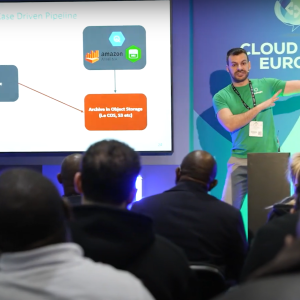SOA, loosely speaking, describes a technology approach whereby applications, usually Web services-based, are standardized across an organization’s infrastructure and built upon reusable models and business processes, as opposed to the large, standalone applications that businesses are used to implementing. The goals of SOA are to give enterprises more flexibility, better data access, and an ability to quickly align their IT strategy according to changes in their business.
As hardware and software vendors target their customers with their latest SOA products, there’s an obvious role for services companies to step in with the relevant consulting, implementation, and outsourcing offerings to help clients make sense of what exactly these three initials mean.
A lot of the current offerings from big services firms such as Accenture deal with the assessment stage of the process, which involves identifying where to implement SOA, establishing a business case for it, and developing a strategy for implementation. All this work of course comes before any actual architectural engineering and SOA frameworks are put in place, or before any application building begins.
The reason that there’s so much preparation involved is that services companies are staking a lot of future business on SOA adoption, according to David Nichols, the global SOA leader for Accenture’s technology and delivery group.
It’s going to have an absolutely huge impact on clients, he said – especially in the late stages when SOA reaches becomes the default method of building services and integrating systems.
Nichols compared this industrialization point to the switch in the early 1990s from client server systems to distributed IT environments. Now the application-centric, distributed model is turning into a service-oriented one defined by business processes and unconstrained by programming language or by legacy or existing systems, which can be integrated into and become working components of an SOA environment.
Nichols said each of Accenture’s five operating group — products, resources, financial, communications and high tech, and government-is working to develop industry-specific offerings. One of the keys is to find best practice business processes specific to a given industry. For example, Nichols said Accenture had identified more than 100 processes for its future banking model.
This sort of modeling is happening in all of Accenture’s business segments, such as its first project under the new R&D initiative–integrating the many processes involved in an electronic drug prescribing.
Over at HP, the company offers a similar range of industry-specific and cross-industry SOA life cycle services alongside its software and server/storage products, explained Terri Schoenrock, the executive director of SAO for HP Services’ consulting and integration practice.
SOA and computing services have a very close tie-in, Schoenrock said. The advantage of SOA to a business or public enterprise are the ability to leverage legacy and existing environments while taking advantage of the most current technology and capabilities on the market.
Fellow outsourcers EDS Corp pursues much of its SOA strategy through what it calls agile applications architecture, which isn’t an actual product it sells a clients, but an introductory process by which it is developing new services around its integration, apps, and modernization offerings, according to Sean Wiley, director of the program within EDS’ product management group.
EDS launched its A3 practice about three years ago, when it had to fund many applications across several of its target verticals. The company noticed that the integration support services for these projects shared many similar components, as did the portal and data warehouse aspects.
So EDS designed its applications to sit on top of its standardized data centers, and it looked at best practices and vendor products to figure out the best way to assemble them into an SOA framework, Wiley said. The company also worked with its software partners to identify areas in which EDS would develop its own applications and components.
For example, EDS now offers Web-services for airline booking, which replace the traditional mainframe-type applications that the big carriers use for booking, managing passengers and cargo, status levels, reservations, and pricing.
But because not all business scenarios call for an SOA approach–vendors say that one of the most important steps of any SOA assessment is determining which areas of an organization are suited for SOA-EDS doesn’t have its own SOA practice apart form its traditional applications team. Instead, the company is training all of its developers some SOA skills, Wiley said.
Despite all the hype surrounding SOA, Wiley said enterprises aren’t running on SOA yet. Instead, they’re trying pilots, small-scale project, or perhaps testing it in a certain department. And businesses are most likely to first transfer their internal business processes to an SOA setting, not their outsourced services.
Wiley said EDS sees the best SOA opportunities from companies that are facing a lot of economic pressure or going through a lot of change, such as acquisition-heavy businesses. He also mentioned government agencies and insurance firms, that are typically conservative in their business strategies, but have ended up with redundant systems and bulky processes over the years.
HP’s Schoenrock said the main drivers for SOA services include better top line growth, customer care, return on investment, product deployment, and lower operational and production costs. He said companies will measure their success in reduced IT costs, increased transaction speed, [and] decreased time implementing business change.
Yet each of the vendors also spoke of several big challenges clients have when implementing SOA. As always, there are plenty of questions around performance, security, and reliability. Nichols from Accenture said security is a big concern, as clients have spent the past several years tackling security issues and worry that a brand new IT architecture might open up new gaps.
In terms of data access, most SOA system will still be fishing data from a previous distributed environment, which might require new data models and architecture to run correctly, Nichols added.
Wiley said EDS was seeing potential performance frustrations with the messaging standards and brokers used to communicate between systems and business process. Nichols said the XML standard, which is a pretty simple method for passing messages through Web services, gobbles up a bunch of computing resources and can really drag down overall system performance.
Wiley added that this dilemma creates a whole new set of issues, such as redesigning traditional message brokers to handle message failover and routing, or adding hardware for XML compression and caching. But within the next few months Wiley said some clients will be able to manage high-volume SOA messaging.
Nichols also said the sheer number of SOA offerings from hardware and software providers is also a headache for clients. A lot of clients say ‘I’ve seen this before,’ and they don’t see the difference of SOA, Nichols said. But it’s this same confusion, after all, that gets Accenture and other services companies in the door in the first place, ready to take their clients’ hands as they make the transition to an SOA setting.






